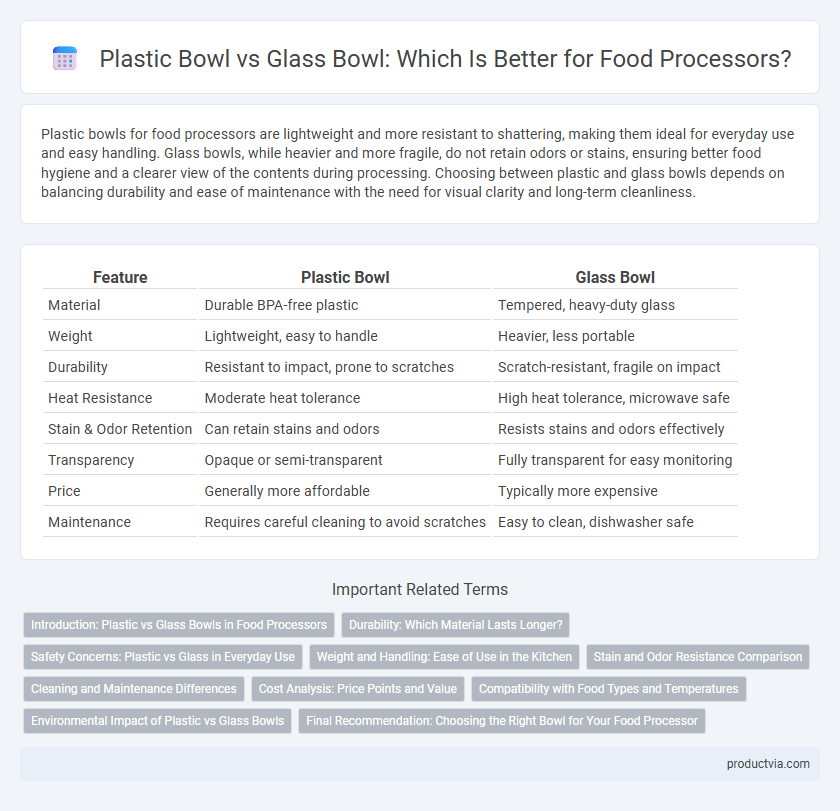Plastic bowls for food processors are lightweight and more resistant to shattering, making them ideal for everyday use and easy handling. Glass bowls, while heavier and more fragile, do not retain odors or stains, ensuring better food hygiene and a clearer view of the contents during processing. Choosing between plastic and glass bowls depends on balancing durability and ease of maintenance with the need for visual clarity and long-term cleanliness.
Table of Comparison
| Feature | Plastic Bowl | Glass Bowl |
|---|---|---|
| Material | Durable BPA-free plastic | Tempered, heavy-duty glass |
| Weight | Lightweight, easy to handle | Heavier, less portable |
| Durability | Resistant to impact, prone to scratches | Scratch-resistant, fragile on impact |
| Heat Resistance | Moderate heat tolerance | High heat tolerance, microwave safe |
| Stain & Odor Retention | Can retain stains and odors | Resists stains and odors effectively |
| Transparency | Opaque or semi-transparent | Fully transparent for easy monitoring |
| Price | Generally more affordable | Typically more expensive |
| Maintenance | Requires careful cleaning to avoid scratches | Easy to clean, dishwasher safe |
Introduction: Plastic vs Glass Bowls in Food Processors
Plastic bowls for food processors offer lightweight durability and resistance to breakage, making them practical for everyday use. Glass bowls provide superior scratch resistance and do not stain or retain odors, ensuring a cleaner food preparation experience. Choosing between plastic and glass depends on priorities such as weight, durability, and maintenance preferences.
Durability: Which Material Lasts Longer?
Plastic bowls for food processors offer excellent impact resistance and are less likely to shatter if dropped, making them highly durable for everyday use. Glass bowls, although more prone to breakage from impact, resist scratching and staining better over time, preserving their appearance and function. Overall, plastic bowls tend to last longer under heavy use due to their flexibility and shock absorption, while glass bowls maintain durability through resilience to wear and chemical damage.
Safety Concerns: Plastic vs Glass in Everyday Use
Plastic bowls for food processors pose risks of scratches and micro-cracks that can harbor bacteria, raising safety concerns during everyday use. Glass bowls offer a non-porous, BPA-free alternative that resists stains and odors, enhancing hygiene and food safety. However, glass is prone to breakage if dropped, requiring careful handling to prevent injury.
Weight and Handling: Ease of Use in the Kitchen
Plastic bowls for food processors are significantly lighter, enhancing ease of handling and reducing fatigue during food preparation. Glass bowls, while heavier, provide greater stability on countertops, minimizing movement during processing tasks. The choice between them depends on prioritizing lightweight convenience or steady handling for consistent performance.
Stain and Odor Resistance Comparison
Glass bowls for food processors offer superior stain and odor resistance compared to plastic bowls, which tend to retain strong food odors and develop discoloration over time. The non-porous surface of glass prevents absorption of oils and pigments, ensuring easier cleaning and maintaining food purity. Plastic bowls, especially those made from lower-quality materials, are more susceptible to scratches that harbor odors and stains, diminishing their long-term usability.
Cleaning and Maintenance Differences
Plastic bowls in food processors are lightweight and less prone to shattering but tend to retain stains and odors, requiring more frequent deep cleaning to maintain hygiene. Glass bowls offer superior resistance to staining and do not absorb odors, making them easier to clean and more durable over time against discoloration. However, glass bowls require careful handling to prevent breakage and may be heavier, influencing user preference based on cleaning convenience and maintenance needs.
Cost Analysis: Price Points and Value
Plastic bowls for food processors typically offer lower upfront costs, making them more budget-friendly for casual users, while glass bowls tend to have higher price points due to durability and premium feel. In terms of value, plastic bowls may wear faster and scratch easily, leading to potential replacement expenses, whereas glass bowls resist stains and odors, providing long-term savings through enhanced longevity. Consumers prioritizing cost-effectiveness should weigh initial price against durability benefits to determine the best investment for their food processing needs.
Compatibility with Food Types and Temperatures
Plastic bowls in food processors offer excellent compatibility with a wide range of food types, including acidic and hot mixtures, due to their resistance to staining and heat distortion. Glass bowls provide superior durability for handling high temperatures and avoid odor retention, making them ideal for processing hot soups or blending ingredients with strong flavors. Both materials support diverse culinary tasks, but glass bowls enhance safety when working with high-heat foods, while plastic bowls excel in lightweight convenience and chemical resistance.
Environmental Impact of Plastic vs Glass Bowls
Plastic bowls for food processors contribute significantly to environmental pollution due to their non-biodegradable nature and reliance on fossil fuels during production. Glass bowls, being made from natural materials, offer a more sustainable alternative with higher recyclability and reduced chemical leaching. Choosing glass over plastic helps minimize landfill waste and lowers the overall ecological footprint in food processor usage.
Final Recommendation: Choosing the Right Bowl for Your Food Processor
Plastic bowls for food processors offer lightweight durability and impact resistance, making them ideal for everyday use and ease of handling. Glass bowls provide superior scratch resistance and do not retain odors or stains, ensuring long-term food safety and clarity during processing. Selecting a glass bowl is recommended for those prioritizing hygiene and durability, while plastic bowls suit users seeking affordability and portability.
Plastic bowl vs Glass bowl for food processors Infographic

 productvia.com
productvia.com